Eylure
At the end of the Second World War, the Aylott brothers, Eric and David, returned to work as make-up artists in the British film industry. Their entry into the business had been through their father, David Henry Aylott [1885-1969]. He had started out directing – making his first film ‘Mad Dog’ in 1906 – but had also worked as an actor before moving into make-up, a not uncommon story.
See also: Early Movie Make-up
Film work paid well but was intermittent, so the brothers decided to start a sideline to tide them over between pictures. The idea they came up with was to make and sell artificial eyelashes. David had been taught the art of wig making before the war and he showed Eric how it was done. Eric thought there must be an easier way to make them and, after some experiments, developed a better technique (Aylott, 1995, p. 23).
The method Eric developed began by knotting strands of hair on a nylon thread that was secured to a strip of greaseproof paper mounted on a wig block. The knotted double strands of hair were then straightened out with shellac before the lash strips were divided, trimmed and packed. All this was filmed by Associated British-Pathé in 1949, so it is possible to see exactly how it was done.
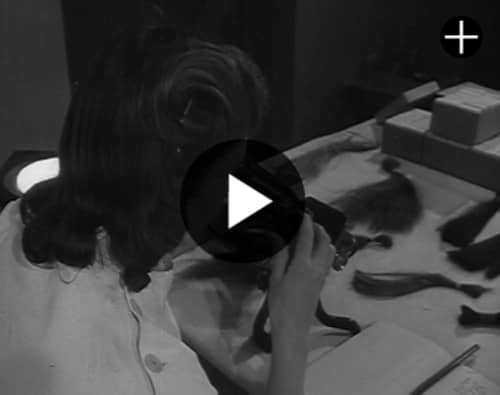
A British Pathé film which shows women making Eylure Eyelashes in ‘The Shack’ in September, 1949. The woman featured in the film may be the wife of Gordon Douglas Aylott [1919-2000], Eric and David’ younger brother.
See also: False Eyelashes
Business established
To set their new enterprise on a firm footing, the brothers founded Eylure Ltd. in March, 1947, with a capital of £100 in 100 £1 shares. The business was registered at 21 Woodhall Lane, Welwyn Garden City, where Eric and David were living with their parents.
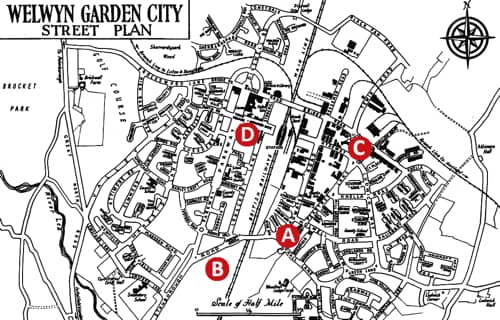
Above: Eylure locations on a 1950 Welwyn Garden City Street Plan:
A. 21 Woodhall Lane; B. Twentieth Mile Pit; C. 58-60 Bridge Road East; D. 16 Wigmores South.
The directors of the company were Eric V. Aylott, David H. Aylott and Eric D. K. Turner [1920-1967], all of whom had shares in the company. Eric Turner was brought in to run things as the Aylott brothers kept working as make-up artists. They would continue to do so until the 1960s. Eric’s last movie was ‘Village of the Damned’ (Metro-Goldwyn-Mayer British Studios, 1960); David’s last job as a make-up artist was for ‘The V.I.P.s’ (Metro-Goldwyn-Mayer, 1963), where he did Elizabeth Taylor’s [1932-2011] make-up. Turner would later leave Eylure to set up his own business, The Eric Douglas Company. When it got into difficulties, the brothers approached him and bought his Eylure shares giving them total control of the company.
Needing a base of operations, the brothers rented a small building from the Welwyn Garden City Company – an organisation set up by the British Government to develop Welwyn Garden City after the war – in a site not far from the family home. Nicknamed ‘The Shack’, rent for the building was cheap as it was situated in a disused gravel pit where it had been previously used to run that operation. By 1951, their business had expanded into a second shed.
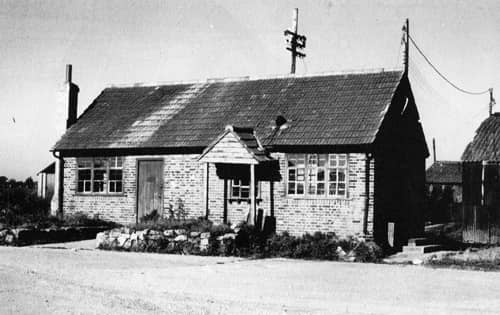
Above: ‘The Shack’, Eylure’s original factory situated in the middle of the Twentieth Mile gravel pit on Stanborough Road, Herts.
To announce their new business, the Aylotts placed an advertisement in ‘The Stage’ in July, 1947, declaring that they had artificial lashes for sale in Black, Dark Brown, Medium Brown and Light Brown shades, boxed complete with a tube of adhesive. The adhesive, called Lashfix, was made using equal parts of latex and distilled water (Aylott, 1995, p. 24). Unlike spirit gum, which was normally used to fix hair on stage or screen, Lashfix stretched with the eyelid making it less likely that the lashes would come away when it moved, a common problem.

Above: Lid from a very early set of Eylure Eyelashes. The boxes were sourced from Kettlers in New Oxford Street and the logo was designed by Jack Dale, a scenery designer (Aylott, 1995).
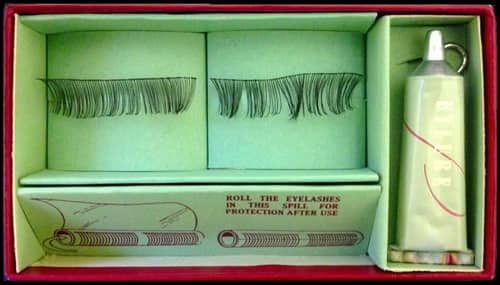
Above: Contents of an early set of Eylure Eyelashes with a pair of eyelashes, a tube of Lashfix, and a space for the curl-retainer pack used to store the eyelashes after use.
The initial market for the eyelashes was expected to be stage, screen and television actresses so the first retail outlets were mainly established in London close to the theatre districts.
By 1953, the brothers were employing a number of outworkers to make their eyelashes. These women were shown how to make them and then given a wig block, a knotting needle, and a quantity of hair so that they could work at home. Their completed lashes were delivered to Eylure where they were sorted, curled and packed into boxes.
New products
Having developed their line of artificial eyelashes and gotten their business up and running, the brothers began adding other lines starting, in 1948, with Eylure Artificial Fingernails made from nylon. By the end of 1949, their product range had expanded even further to include a lip brush, lip tissues, and a powder brush.
Artificial Eyelashes: “Ideal for evening wear. Special types for stage use … with strong adhesive, instructions and patent curl-retaining pack for storage.”
Artificial Fingernails: “Perfect nails at a moment’s notice. The essential standby when nails break or crack. Supplied in alluring shades, or natural for use with varnish.”
Lipbrush: “The finest method of applying any brand of lipstick. Gives a smooth clear outline. … Use as a liner for stage make-up. Pure sable brush with protective cap.”
Lip Tissues: “A companion to the lipbrush that should find a place in every woman’s handbag. For blotting lipstick, wiping off make-up, and numerous other uses.”
Face Powder Brush: “For brushing off or blending face powder.”
By 1953, Eylure had added a lipstick sealer, a cosmetic sponge and an eyebrow pencil. The eyebrow pencils were imported from the Swan Pencil Company of New York, a subsidiary of Schwan-Bleistift-Fabrik, a German company that had been making eyebrow pencils since 1927.
Lipfix: “[C]omplete with applicator brush—keeps lipstick kiss and smearproof for at least 8 hours.”
Tru-Blend Cosmetic Sponge: “[M]ade from fine Latex foam—shaped for smooth application of Foundation Lotions, etc.”
Tru-Tone Eyebrow Pencil: “[S]upersoft in 16 fascinating shades.”
By 1954, Eylure had introduced ‘ready trimmed’ lashes packaged in a new box with the lashes displayed on a more attractive, curved, plastic mount. Other new products introduced during the 1950s included Lipfix, a lipstick sealer (1955), and Liqua-Liner and Liqua-Liner Brush (1959). Like the Eylure Tru-Tone Eyebrow Pencils, Liqua-liner was imported from the United States.
Expansion
As well as supplying a growing British market, Eylure began exporting its products through distributors in Europe, America and elsewhere. Opening new markets appears to have been a fairly haphazard process with potential distributors approaching Eylure rather than the company looking specifically for export opportunities. However, the increasing demand for its products meant that the company needed more space and, by 1958, it had leased additional premises in Bridge Road, Welwyn Garden City.
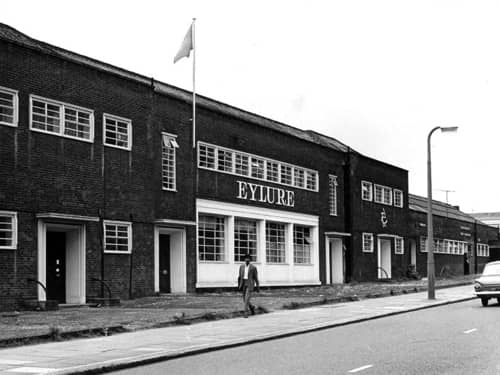
Above: 1970 Eylure factory in Bridge Road, Welwyn Garden City. The building still stands today. The company started out at number 56 but later extended through to number 60. Eylure would remain here until 1971 when it moved its operations to Cwmbran New Town.
Finding additional process workers for their factory was another problem. Deciding they needed to establish another factory somewhere else in Britain, the brothers used services of the Confederation of British Industry to find a place with a good labour supply. In 1962, after a long search, Eylure began operations in Cwmbran New Town, Monmouthshire, South Wales, another new housing development.
Like Welwyn, Eylure’s first site in Cwmbran was also a discarded building, the Avondale Hostel, erected to house workers employed to construct the new town. Eylure would extend its operations in Cwmbran, completing a purpose-built factory there in 1966 before relocating its entire business there in 1971.

Above: 1967 The Eylure factory in the Grange Industrial Estate, Llanfrechfa Way, Cwmbran designed by Richard Matthews.
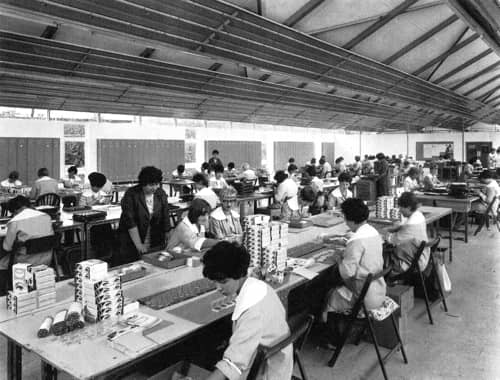
Above: Interior of the Eylure factory in Cwmbran.
One of the reasons for Eylure’s increased need for eyelashes was that the company had begun making lashes for other cosmetic companies to sell under their own labels. Starting with Max Factor and Elizabeth Arden in the late 1950s, Eylure would go on to make lashes for firms like Helena Rubinstein, Dorothy Gray, Revlon, Lentheric, Lancôme and Avon.
Through the 1960s, Eylure was exporting its own products, and lines it made for others, into places such as France, Germany, Belgium, Holland, Denmark, Spain, America, Canada, Australia, New Zealand, Africa, the Middle East, Thailand, Singapore, Hong Kong and Japan with its biggest market being the United States. The export earnings that Eylure achieved for the British economy were recognised by the company receiving a Queen’s Award to Industry in 1966.

Above: 1966 Queen’s Award to Industry.
Eyelashes
False eyelashes were company’s biggest seller and, as make-up fashions in the 1960s placed an increasing emphasis on the eyes, sales climbed. This fashion trend came from a number of sources. British models like Jean Shrimpton [b.1942] and Lesley Hornby (Twiggy) [b.1949] were very influential in this period and their make-up routines were widely copied by fashion-conscious younger women. Both emphasised eye make-up, and wore false lashes.
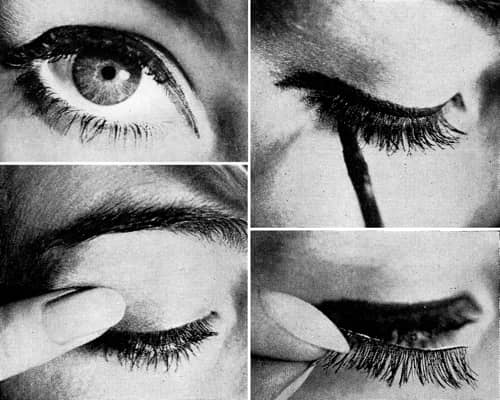
Above: 1963 Images (modified) from a British Vogue article in which Jean Shrimpton demonstrated her make-up techniques. The false lashes she used were from Eylure.
Eyelash sales were also stimulated in the 1960s by the release of ‘Cleopatra’ in 1963.
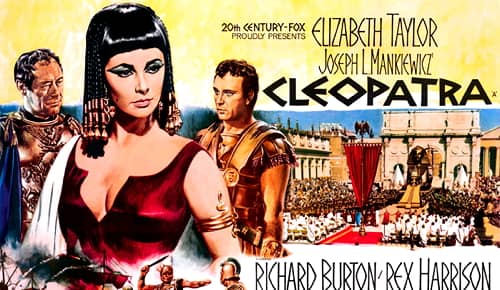
Above: 1963 Cleopatra (Twentieth Century-Fox).
David Aylott made much of the fact that he had designed the eye make-up used by Elizabeth Taylor. He had worked on the film when production started at Pinewood Studios in 1961, with Elizabeth Taylor as Cleopatra, Peter Finch [1916-1977] as Julius Caesar and Stephen Boyd [1931-1977] as Mark Antony. However, he was not involved in the production after it moved to Rome following Elizabeth Taylor’s recovery from an illness which halted filming in England. Peter Finch and Stephen Boyd had other commitments by then so the Rome production engaged Rex Harrison [1908-1990] as Julius Caesar and Richard Burton [1925-1984] as Mark Anthony.
In the United States, false eyelash sales also got a boost from David Aylott’s appearance on the CBS Television Network program ‘What’s My Line’ in September, 1964. His promotion of Eylure and false eyelashes was helped by the panelist Dorothy Kilgallen [1913-1965] who was wearing a pair from Eylure. Kilgallen promoted the use of false lashes during the show, stating that this “is the year of frank false eyelash. Women don’t even bother pretending any more that they’re not fake”.
Above: 1964 ‘What’s My Line’ featuring David Aylott (Broadcast September 27, 1964).
In 1962, the company introduced fur lashes made from seal skin, adding individual fur lashes in 1965. Eylure had been making fur lashes for shop window mannequins as early as 1953 but the Aylotts only added this type of lash to its consumer range after seeing examples sold by David Turner’s company, The Eric Douglas Company, under its trade name ‘Furls’ (Aylott, 1995, p. 124).
In 1964, the company began selling Sable-Styled Eyelashes. These were self-adhesive and came in two thicknesses (double and triple) in Black, Dark Brown, and Medium Brown shades, with Green and Blue added later in the year.
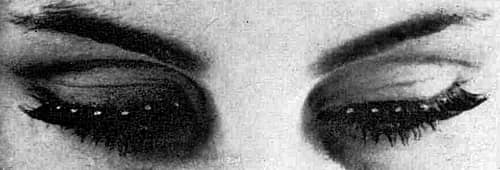
Above: 1966 Jewelled Fur Eyelashes.
Other lash styles launched in the 1960s included: Jewelled Fur Eye Lashes (1966); Double Outer Fringe Lashes in Black, Brown, Blue Jewel Mink, Green Jewel Mink, and Heavenly Jewel Mink (1966); Gold and Silver Lashes (1967); 3D Eyelashes in Coquette, Mannequin and Sophisticate densities in Black and Brown shades (1967); First Flutter Lashes in real hair or fur (1968); and Spikey, Demi Spikey, Fluffies, Moonrakers, Bobby Dazzlers and Underlashes (1969). These additions meant that, by the end of the decade Eylure, was making over 30 different styles of eyelashes in real hair or fur.
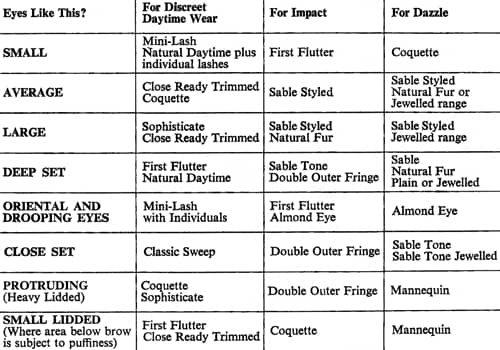
Above: 1969 Eylure lash suggestion guide.
Recognising that perceived or actual difficulties in selecting, fitting or reusing their lashes could affect sales, Eylure also took steps to ameliorate each of these problems.
To help make applying their lashes easier, the company introduced self-adhesive lashes in 1963, and a Lash Applicator in 1964.
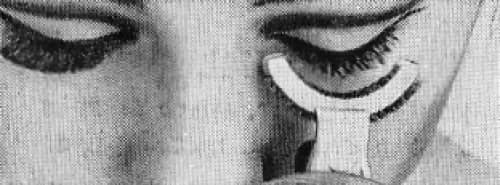
Above: Eylure Lash Applicator.
Lash Applicator: “Fixes eyelashes in seconds! This new applicator attaches lashes firmly to the natural contour of the eyelid. It’s quick and simple to use.”
Eylure also provided detailed instructions on how to apply their false eyelashes.
Like any new beauty technique, putting on false lashes will take a little practice. But you’ll soon be perfect and be able to put them on quickly and easily. Just follow these simple steps . . .
1. Remove eyelashes carefully from plastic mounts using the TUBE PIERCING PIN to ease the corners away.
2. Hold eyelashes in front of the eyes to determine the correct width. The eyelashes should not extend beyond your own eyelashes at inner corner of eyes. Shorten them with short sharp cuticle scissors if necessary.
3. Grip eyelashes firmly as near band as possible with Eylure Applicator, pair of tweezers or your fingers, depending on which you find easiest to use.
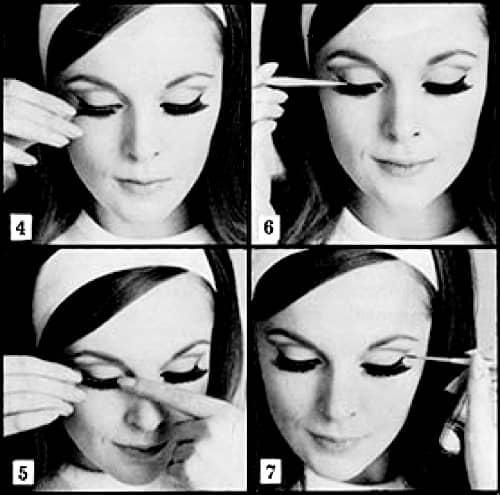
Above: 1965 Eylure eyelash application steps 4-7.
4. Place the mirror low down below eye-level, and with the chin up look down the side of your nose into it so that your eyes are half closed and relaxed and you can see exactly where the lash is being placed.
5. Now, still looking down, bring the lash in at right angles and touch the middle of the lash on the centre of your eyelid as close as possible to the roots of your natural lash.
6. Gently push each corner into position.
7. Use Liqualiner or Eylure pencil to extend the line of the lash at the outer corner of the eye.
With Real Hair Lashes you can use a little mascara to blend them with your own. (DO NOT USE MASCARA WITH FUR LASHES OR WITH THE HEAVIER TYPE OF HAIR LASHES).
TO REMOVE lashes, hold the outer edge of the lash and gently ease away from the eyelid.(Eylure brochure, 1965)
Also see the company booklet: Fixing your Eyelashes. (c.1963)
To help with cleaning the lashes between uses the company added a Lash Cleaning Kit in 1966. The following year, to make selection easier, Eylure put Trylash Bars in various shops and stores around the country. The stands included patented plastic ‘testers’ which allowed women to view different lash styles without applying them. Once they had made a purchase, trained staff were on hand to provide advice on how best to fit them.
Nails
Artificial nails were another major line for Eylure. Until the early 1960s, these only came in one size in seven shades: Autumn Pink, Natural Pink, Pink Pearl, Dusky Rose, Coral, Rose Mist, and Carnation Clear with Frosted Platinum, Frosted Peach, and Frosted Pink, with Frosted Coral added in 1968. In 1964, the company introduced a second style called Slimline, more suited to longer slender hands, in four shades: Carnation Clear, Natural Pink, Rose Mist, and Pink Pearl.
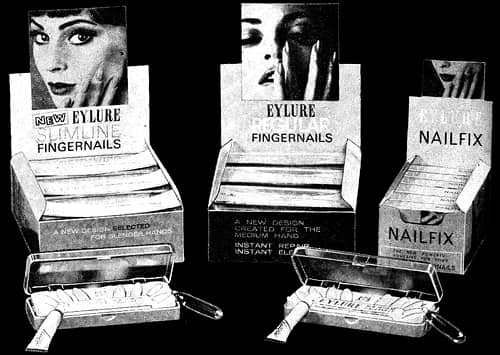
Above: 1964 Eylure Slim Line Fingernails, Regular Fingernails and Nailfix. The clear capsules leaning against the Slim Line and Regular packs contain Nailfix remover.
In 1968, the company added three additional shapes – Short Trim, Small Size and Long Line – which meant that it now had sizes to suit most hands and tastes.

Above: 1969 Eylure Nail Guide.
Regular: “For average sized hands. Give extra length to natural fingernails.”
Slim Line: “For the long slender hand.” Styles: Standard only.
Short Trim: “For women who find it difficult in wearing long nails. Comfortable to wear.” Styles: Standard and self-adhesive.
Small Size: “For small hands. Very natural looking.” Styles: Standard and self-adhesive.
Long Line: “To make long natural fingernails look even longer.” Styles: Standard and Self-adhesive.
Eylure also introduced Trynail bars into select shops and stores. Like the Trylash bars these included plastic testers that women could use to see how different nail styles looked on their hands.
Make-up
By 1962, Eylure was selling Eylure Eyelashes; Easy-Fix Fingernails; American Eyeliner, Eyebrow and Lipline Pencils; Liqua-Liner, Liqua-Liner Remover and Liqua-liner Brush; Glide-Line Lip Brush; Face Powder Brushes; Oily Nail Polish Remover; Cosmetic Sponges; and Eymatic Mascara, an automatic mascara. Like the Liqua-Liner and the make-up pencils, Eymatic was imported from America.
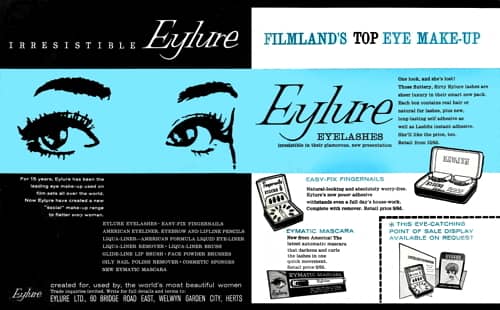
Above: 1962 Trade advertisement for Eylure products.
See also: Automatic Mascara
During the 1960s Eylure expanded its make-up range starting with some eye make-up lines – Shadoliner, Shadomatte, Shadobrow and Eylight Pearl Oversheen – in 1964.
Shadoliner: “Cake eye make-up that doubles as shadow or liner.” Shades: Black, Charcoal, Dark Brown, Mid Brown, Blue-Black and Green-Black.
Shadomatte: “[S]oft, brush-on-dry eyshado in ten subtle fashion shades. Applies easily . . . won’t crease.”
Shadobrow: “[S]ubtle way to shape and colour eyebrows with a natural look.” Shades: Charcoal, Dark Brown and Light Brown.
Eylight Pearl Oversheen: “Dramatic highlight effect that can be worn over or under Shadomatte.” Shades: Natural Pearl, Gold and Silver.
Other make-up lines that followed included: Disguise, a creamy, medicated foundation in Ivory, Pale Peach, and Tan shades (1967); Shadopearls, a pearly eyeshadow in White, Blue, Green Haze, Wild Lilac, Golden Sands, and Pink Champagne shades (1969) with Aubergine, Brick, Aqua Haze, Frosted Olive, Brown Haze and Smokey Gray shades added in 1971; Block Mascara in Black and Brown shades (1969); Roll-On Mascara, an automatic, waterproof mascara with brush applicator (1969); matching Eylure Lipsticks and Nail Polish (1969); and a range of compacts.
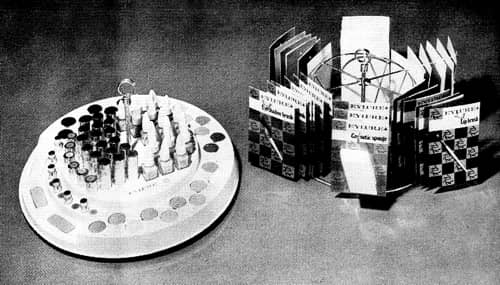
Above: 1969 Eylure display stands. Left: Lipstick, nail polish and eye make-up. The matching lipsticks and nail polishes came in Icicle Pink, Iced Mango, Raspberry Mousse, Dusky Rose, and Pastel Mink shades with an additional Spicy Orange shade in the lipstick and Pink Pearl in the nail polish. There were also new Blue Haze, Green Haze and Cream shades of Shadomatte. Right: Assorted Eylure make-up accessories including the Eyeliner Brush, Shadow Brush, Lip Brush, Blending Brush, Shadow Applicator and Cosmetic Sponge.
In 1968, the company also set up the ‘Let’s Face It’ make-up centre in the company’s new London address at 8 Grosvenor Street. The centre had a beauty room kitted out with Eylure beauty products where customers could experiment with make-up for free or pay for a consultation. It would remain open until the lease expired in 1971.
Other lines
Other products added during the 1960s included: Folding Eye-Liner Brush, Nailfix Remover, Face Savers wash cloths, and Corinda (emery) Boards (1965); an Eyelash Curler similar to the one developed by Kurlash (1968); Beauty Light mirror, and Eye Magic eye drops (1969).
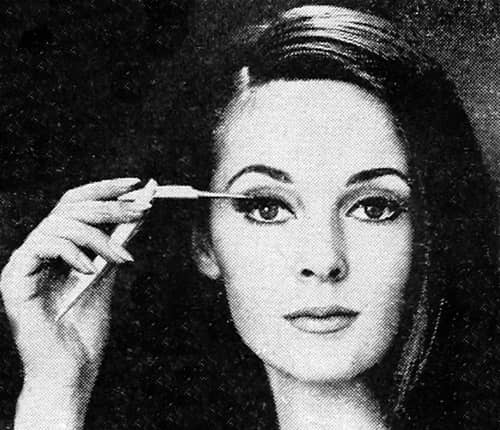
Above: 1965 Folding Eye-Liner Brush.
Folding Eye-liner Brush: “Angle adjustment that ensures that neither the brush not the hand obscures vision. Also allows mascara to be applied when wearing spectacles.”
Corinda Board: “Diamond hard surface gives you a cleaner, quicker filing action to promote stronger, more beautiful nails.”
Face Savers: “Made with superfine linen, not an ordinary facial tissue. Blot away shine, grime and excess oil without disturbing your make-up.”
Eye Magic: “[A] blue liquid to soothe beautify and brighten the eyes.”
Youth market
A lot of the products Eylure developed in the 1960s were aimed at the youth market. At the time most users of false eyelashes in Britain were in the 15-24 age bracket, less so in the 25-34 age group, with very few over 35 years of age (Guardian, Tuesday, 22nd April, 1969). The introduction of Shadoliner, Shadomatte, Shadobrow and Eylight Pearl Oversheen eye make-up in 1964 allowed the company to suggest various make-up looks for their younger customers and describe how to achieve them. Examples of this include Boopee-Doop Eyes (1964), Spy Eyes (1965) and the Indian Look (1967).

Above: 1964 Boopee-Doop Eyes.
1. Line upper lid with black or brown eyeliner, stopping at the outer corner.
2. Blend in brown shadow along natural fold of eyelid.
3. “Thicken” lower lashes by drawing short downward lines with liner or soft pencil.
4. Shade entire inside of lower lid with white pencil to make eyes appear larger.
5. Apply false eyelashes.
6. Mascara lower lashes only.
Finally purse lips and murmer “Boopee-doop.”(Daily Mirror, Tuesday, October 27, 1964, p. 9)
Lash names like Whoppers, Super-Doopers, Moonrackers, and Bobby Dazzlers were also aimed at younger customers.
The company also sponsored Sweden’s Miss Teen 1967, Birgitta Haglind, to spend a week in London with the Aylott brothers so that she could demonstrate the ‘Swinging London Look’ at the first ‘Teenage Fair’ in Gothenburg, Sweden in November, 1967.
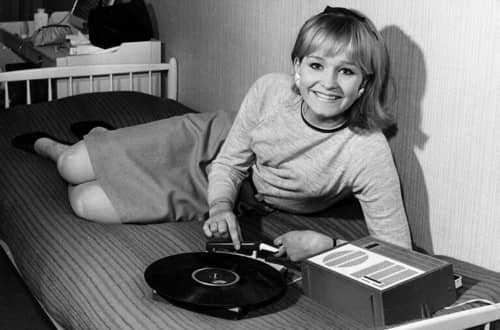
Above: 1967 Birgitta Haglind [b.1950] Miss Teen Sweden.
In 1969, Eylure introduced Miss Eylure eyelashes specifically for teenagers. The lash styles included Under Lashes in Black; First Flutter, in real hair or fur, both in Back or Brown; Ups ’n Downs, individual lashes of fur in Black or Brown; and Half Measures, half-width real hair lashes in Black or Brown.
Diversification
During the 1960s Eylure began manufacturing its lashes outside Britain. In 1965, the company completed a factory Gembloux, Belgium so that it, and the companies it supplied, could avoid the import duties imposed by Common Market, Britain at that time not being a member.
A number of other companies were also manufacturing eyelashes in the 1960s. Eylure’s two most important competitors were Stern, a West German business founded in 1906, and Andrea Raab, a company begun in New York in 1964. Both companies sourced their eyelashes from South Korea which was able to manufacture them more cheaply than Eylure. Eylure would follow suit and by the end of the decade it had also shifted production offshore to South Korea and India.
Manufacturing eyelashes in Korea and India reduced the cost of production but the increased competition, particularly from Andrea Raab in the important American market, meant that Eylure had to lower its prices and reduce its margins. In addition, it was not long before the cosmetic companies that sourced their eyelashes from Eylure would do so direct from the suppliers in the East.
Recognising that demand for their eyelashes might decline, the Aylotts began to widen their commercial interests. As well as developing new lines, such as wigs, the brothers began a program of acquisitions. They were unsuccessful in their attempts to buy Denham Products Ltd. and Denham Tools Ltd., or L. Leichner in 1965, with both companies going to other buyers, but managed to purchase Roberts Windsor – an English soap company established in 1913 – from Union International Ltd. in 1971. Just before they purchased Roberts Windsor, the Aylotts also acquired the distribution rights for Tabac (1971), and then followed this with the rights to distribute a number of other lines including Swiss Bio-facial Cream (1973), and Ten-O-Six from Bonnie Bell (1978).
Sale
In the heady days of the 1960s, the Aylotts were approached by a number of parties interested in buying them out, most notably Revlon. Rather than sell the entire company the bothers elected to sell 25% of Eylure to the Bankers Trust for £200,000 (Aylott, 1995, p. 150). In 1988, the brothers, now in their seventies, sold another minority share to Nobel Consumer Goods and followed with the rest of the company in 1989. Nobel did not hold on to Eylure for long, selling it to Original Additions in 1991. In 2016, Original Additions was acquired by PDC Brands which continues to operate Eylure to this day.
Timeline
| 1946 | The Aylott brothers begin making and selling artificial eyelashes. New Products: Eylure Eyelashes. |
| 1947 | Eylure Ltd. founded at 21 Woodhall Lane, Welwyn Garden City. |
| 1948 | New Products: Eylure Fingernails. |
| n.d. | Larger premises opened in Bridge Road, Welwyn Garden City. |
| 1959 | New Products: Liqua-Liner; and Liqua-Liner Brush. |
| 1960 | Beauty shop opened in Welwyn Garden City. Erida (Accessories to Beauty) Ltd. founded. |
| 1962 | Operations begun in Cwmbran, Monmouthshire. New Products: Eymatic Mascara; and Fur Lashes. |
| 1963 | Erida Productions Ltd. founded. Eylure (of London), Inc. founded in New York. |
| 1964 | Eylure Wigs Ltd. established. New Products: Slimline Fingernails; Sable-Style Eyelashes; and Lash Applicator. |
| 1965 | Factory built in Gembloux, Belgium. New Products: Shadoliner; Shadomatte; Shadobrow; Eylight; Folding Eye-Liner Brush; Nailfix Remover; and Corinda Boards. |
| 1966 | Queen’s Award to Industry. New factory completed in the Grange Industrial Estate, Llanfrechfa Way, Cwmbran. New Products: Lash Cleaning Kit. |
| 1967 | Eylure Cosmetics Ltd. founded in New Zealand. New Products: Disguise medicated foundation. |
| 1968 | False eyelashes and fingernails become subject to a 50% purchase tax in the U.K. ‘Let’s Face It’ make-up centre opened at 8 Grosvenor Street, London. New Products: Short Trim, Small Size and Long Line Fingernails. |
| 1969 | Eylure International Ltd. established in Hong Kong. Ceases selling through chemist wholesalers, all orders now direct. New Products: Miss Eylure collection; Shadowpearls; Roll-on Mascara; Block Mascara; Eylure Lipstick; Eylure Nail Polish; and Eye Magic. |
| 1971 | Administration and sales moved to Cwmbran. ‘Let’s Face It’ make-up centre closed. U.K. distributorship for Tabac. Acquires Roberts Windsor from Union International Ltd. New Products: Miss Eylure Wash ’n Wear Lashes. |
| 1972 | Eylure Benelux established in Belgium. |
| 1973 | U.K. distributorship for Swiss Biofacial Cream. |
| 1978 | U.K. distributorship for Bonne Bell. |
| 1986 | Eylure of London (New York) dissolved. |
| 1988 | Minority share of Eylure sold to Nobel Consumer Goods. |
| 1989 | Nobel Consumer Goods buys the rest of Eylure. |
| 1991 | Eylure sold to Original Additions. |
| 2016 | PDC Brands acquires Original Additions. |
Updated: 9th December 2019
Sources
Aylott, D., & Aylott, E. (1971). The eylure way of make-up: A guide and instruction book. London: Cassell & company Ltd.
Aylott, G. (1995). The eylure story: Tiddlywinks ‘n’ undies. London: Minerva Press.
The chemist and druggist. (1859-) London: Morgan Brothers.

David Howard Frederick Aylott [1914-1991] (left) and Eric Victor Aylott [1917-2010] (right) with a model.
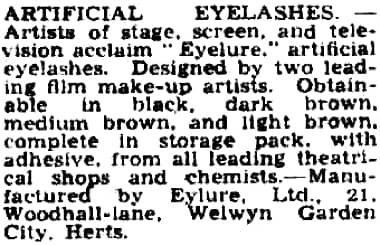
1947 Eylure. This advertisement in ‘The Stage’ is the earliest I have found for the company.

Drawings from the British patent taken out by Eric Aylott for the manufacture of false eyelashes (GB:621,278, 1949).
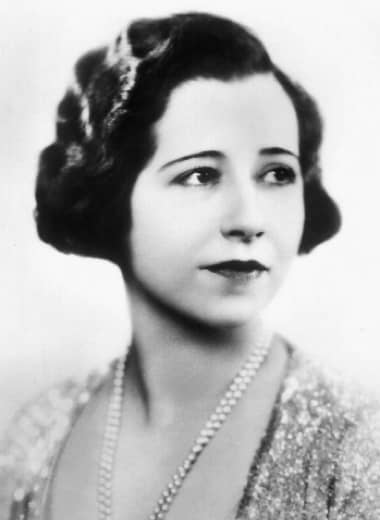
Yvonne Arnaud [1890-1958], one of the first actresses to use Eylure Artificial Eyelashes.
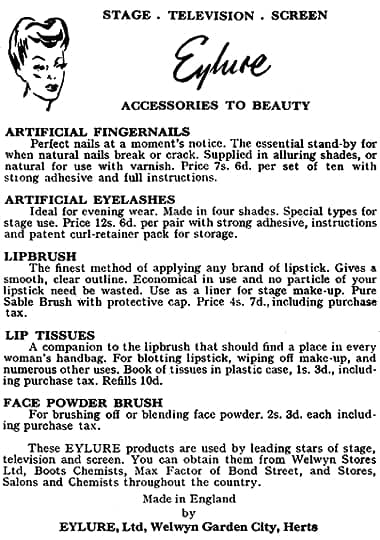
1949 Eylure.
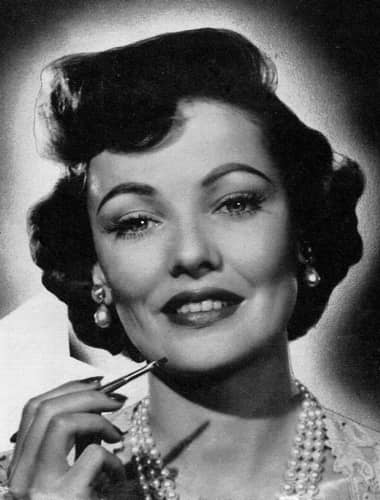
Gene Tierney [1920-1991] photographed using an Eylure Lipbrush. She had met David Aylott on the set of ‘Night and the City’ (Twentieth Century-Fox, 1950). The picture was used on showcards to help boost sales of the lip brush.
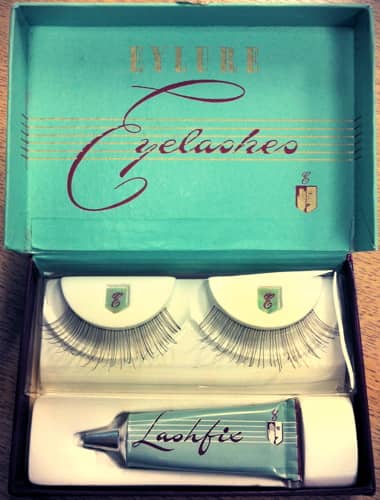
New Eylure pack design with each lash attached to a curved plastic mount. The design was widely copied and variations on this idea became the standard way that sets of false eyelashes were packaged for sale.

1953 Trade advertisement for Eylure.

Barbara Cartland [1901-2000]. A long-term user of Eylure eyelashes.
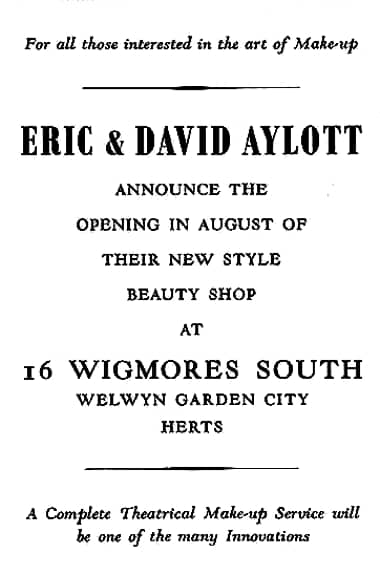
1960 Eylure shop at 16 Wigmores South, Welwyn Garden City.
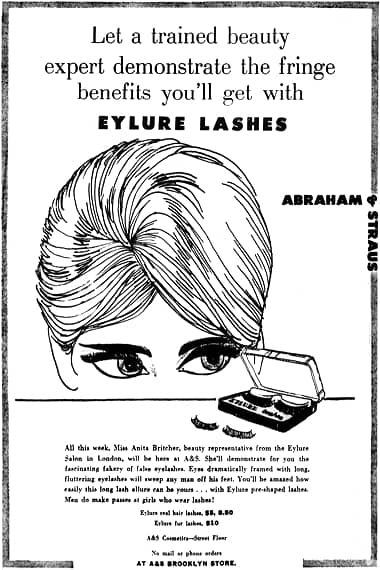
1964 Eylure Lashes.
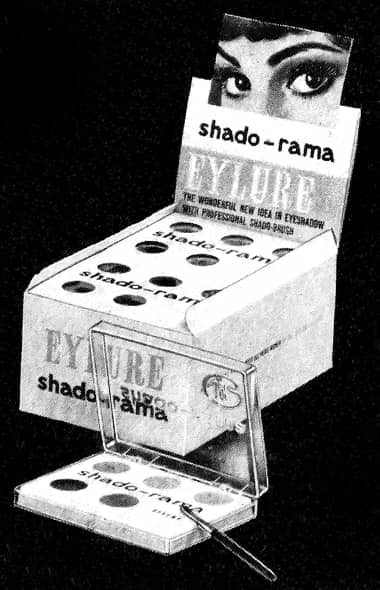
1964 Eylure Shado-rama display.
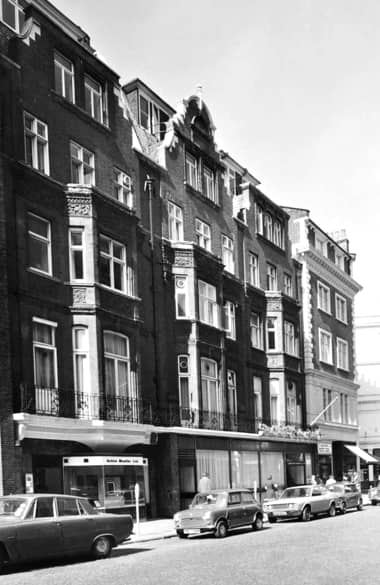
Grosvenor Street, Mayfair. The street has changed much since this photograph was taken in 1974 but the building on the left appears to have been No. 8. It was used as Eylure’s London address, for Eylure Wigs Ltd., and the ‘Let’s Face It’ salon.
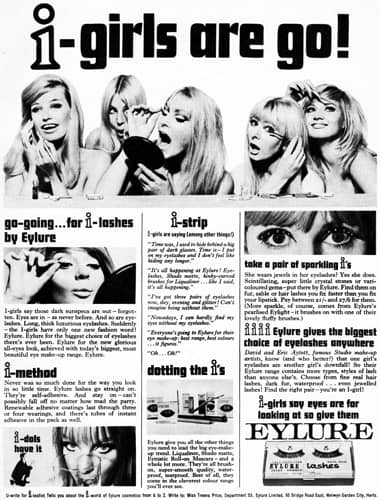
1966 Eylure.
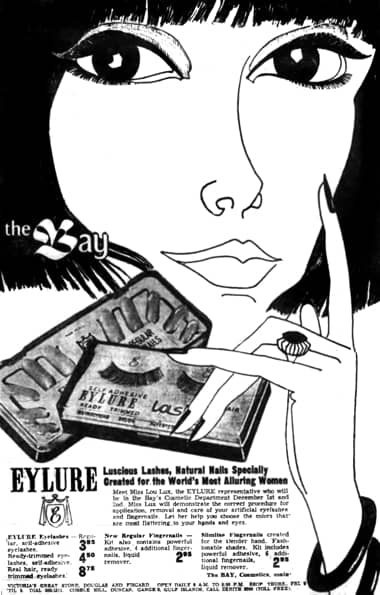
1966 Eylure (U.S.A.).
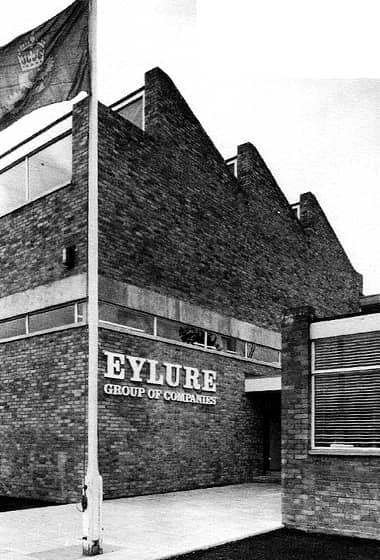
Entrance to the Eylure factory in Llanfrechfa Way, Cwmbran. The Eylure Group of Companies in Britain included Eylure Ltd., Erida (Accessories to Beauty) Ltd., and Eylure Wigs Ltd.
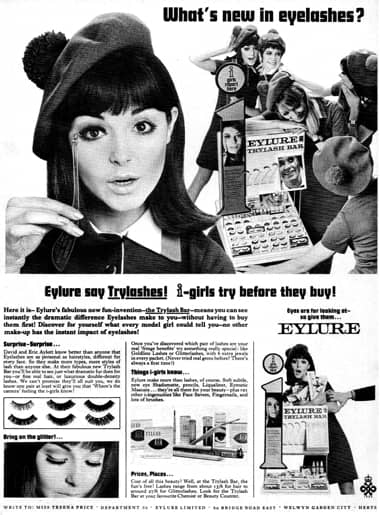
1967 Eylure Trylash Bar. The stand incorporated the Eylure product range, a mirror and a ‘tester’ for holding the lashes in front of the eye.
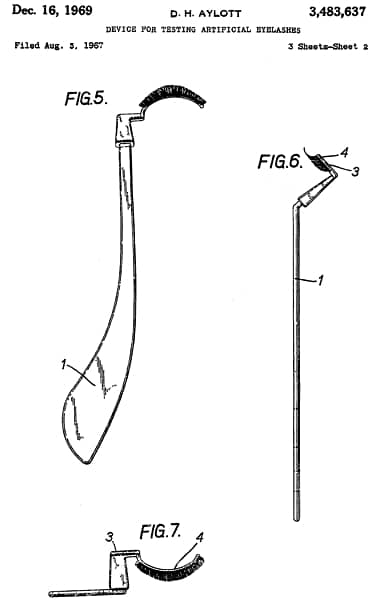
Drawings from the American patent taken out by David Aylott for the eyelash tester (US:3,483,673, 1969).
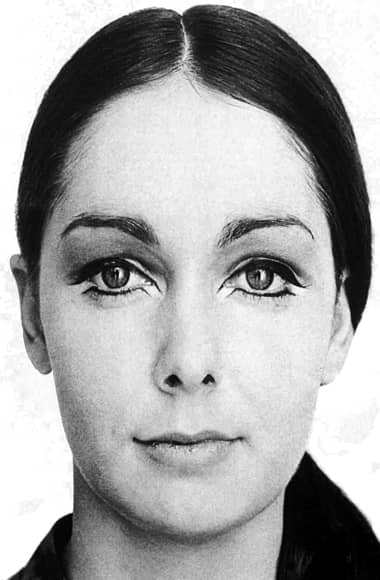
1967 The Indian Look using Black and White Shado-liner, Cinnamon Shadomatte, Gold and Silver Eylight, Eymatic Mascara and Eylure Eyelashes.
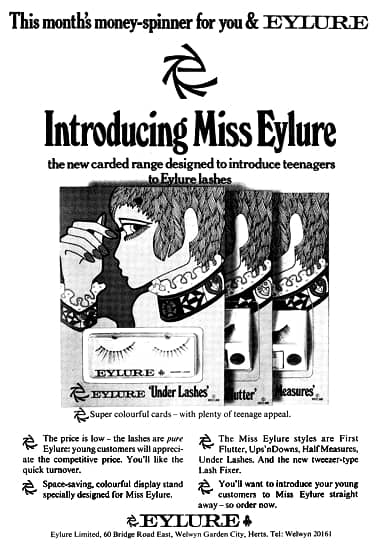
1968 Trade promotion for Miss Eylure.
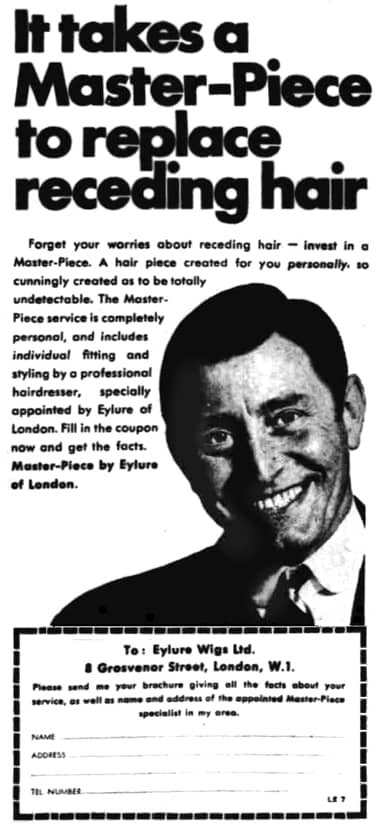
1968 Eylure Wigs. In 1964, the brothers set up Eylure Wigs Ltd. to manage the business.
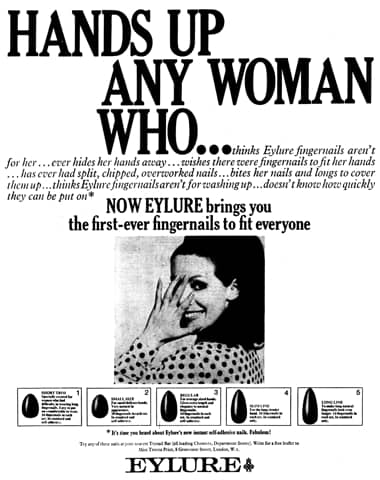
1968 Eylure Fingernails.
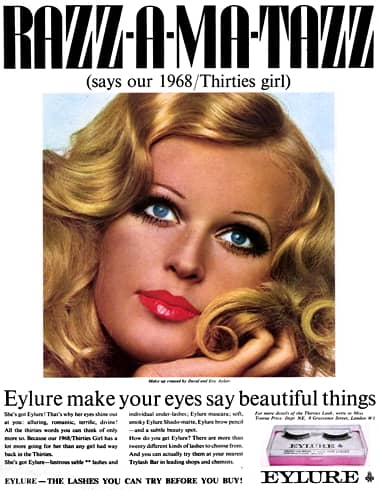
1968 Eylure.
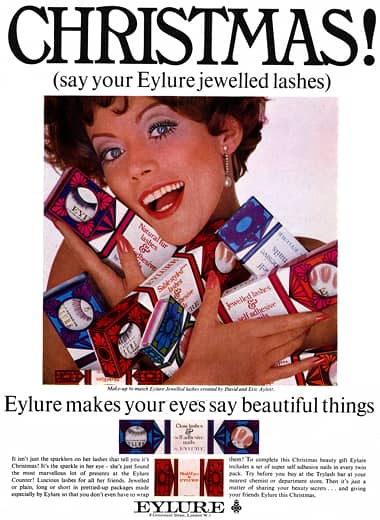
1968 Eylure Jewelled Lashes.
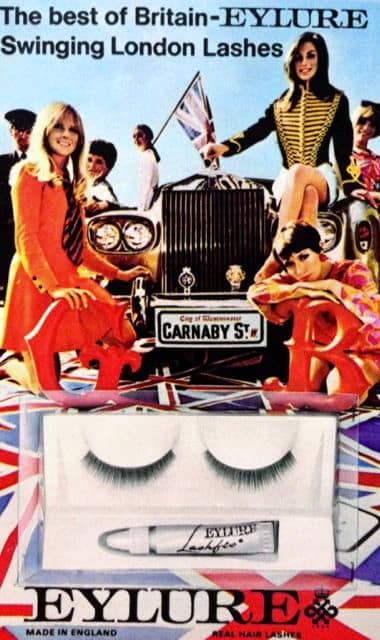
1968 Eylure Swinging London Lashes.
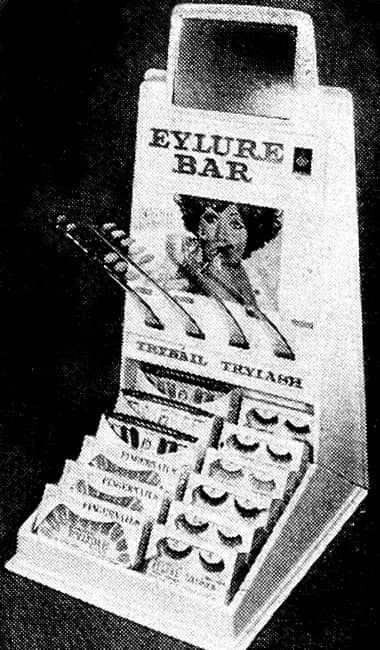
1968 Eylure Bar. It held four Trylash and four Trynail testers that customers could use to try before buying.
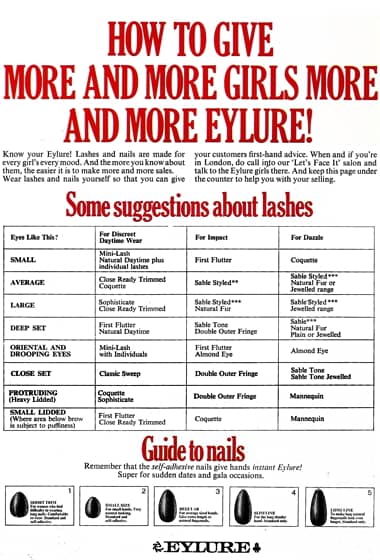
1969 Trade advertisement for Eylure with lash suggestions and nail guide.
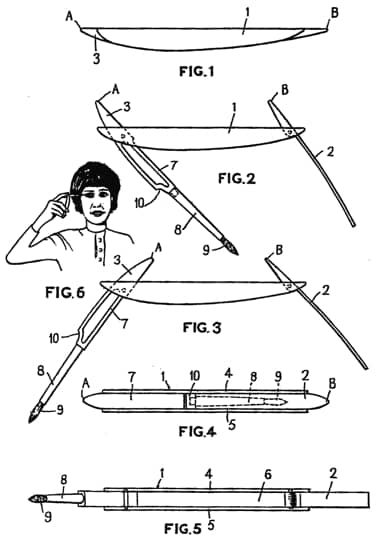
Drawings from the British patent taken out by Eric Aylott for the Folding Eye-liner Brush (GB:1,056,211, 1967).
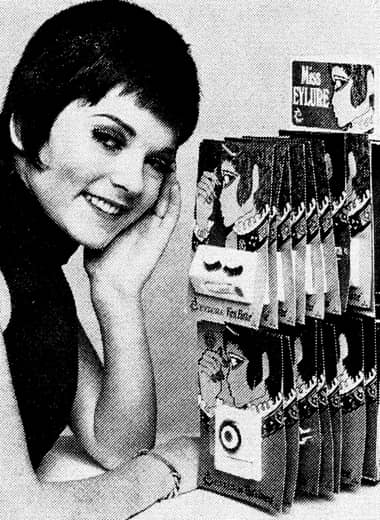
1969 Miss Eylure display stand containing First Flutter real hair and First Flutter fur (Brown or Black), Ups ’n Downs (individual fur lashes in Brown or Black), Under Lashes (Black only), and Half Measures (half-width real hair in Brown or Black). The model appears to be Susan Aylott, David Aylott’s daughter.
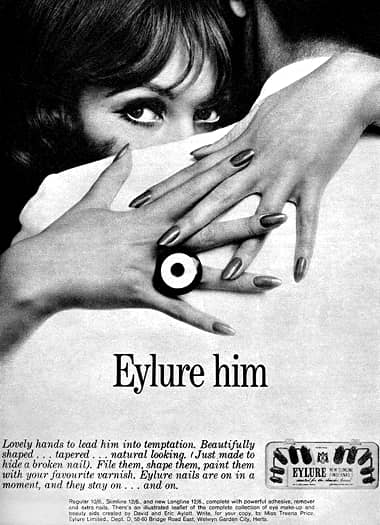
1969 Eylure Nails.
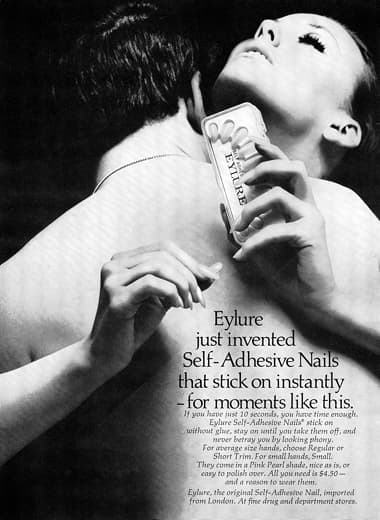
1969 Eylure Self-Adhesive Nails.

1969 Eylure mascara display stand with Block Mascara in Black and Brown in plain or mock tortoiseshell case, and Roll-on Mascara in a white-and-gold case.
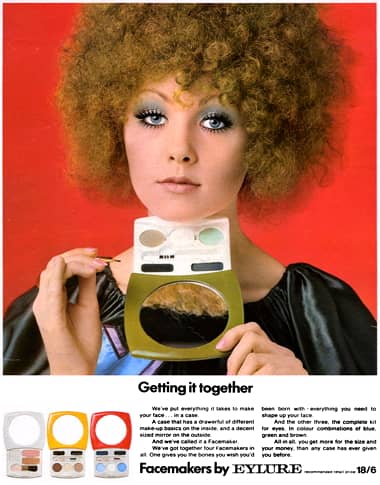
1969 Eylure Facemakers compacts containing cream powders and a brush applicator.
White: Three face-shaping cream powders.
Yellow: Brown-Black Mascara and Cake Eyliner and Cinnamon, Cream and Desert Shadowmatte;
Green: Green-Black Mascara and Cake Eyliner and Green Haze, White and Olive Green Shadowmatte;
Orange: Blue-Black Mascara and Cake Eye-liner and Blue Haze, White and True Blue Shadowmatte.
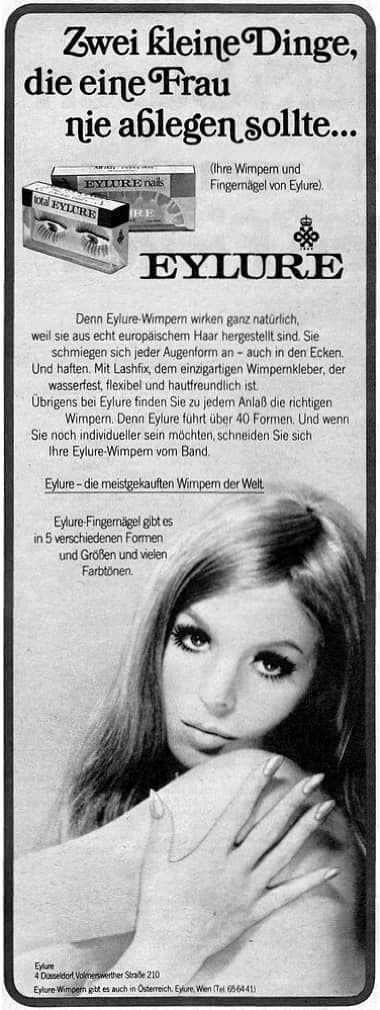
1970 Eylure (Austria).
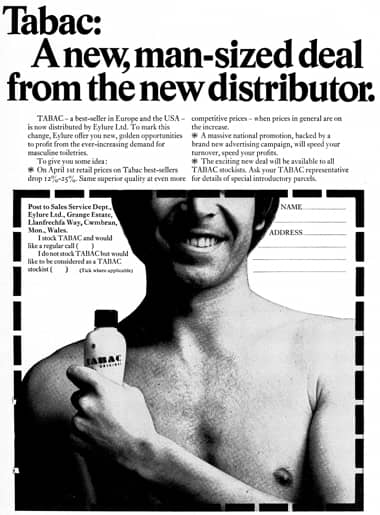
1971 Tabac.
